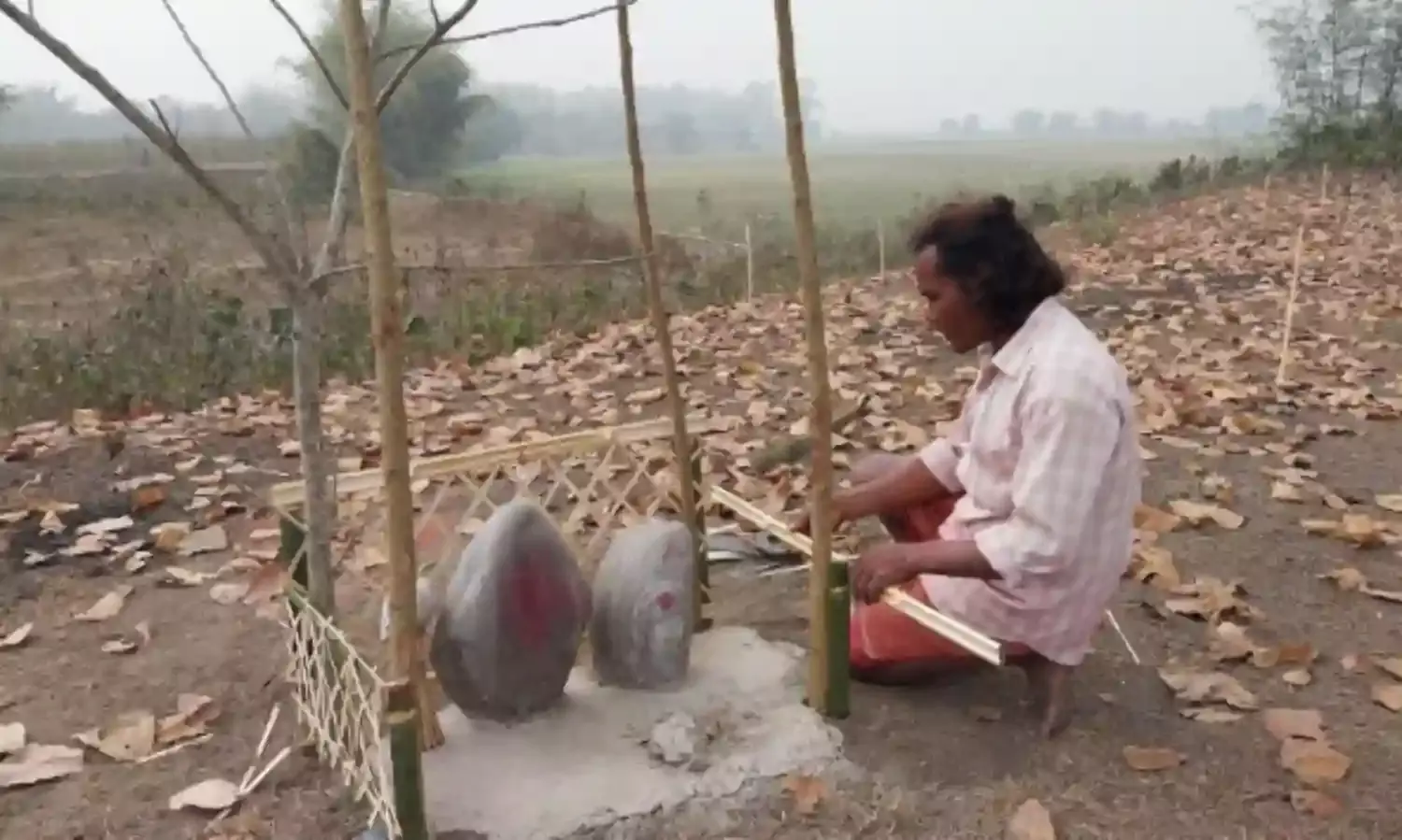
On an afternoon, Shiben Munda slowly walks his bicycle loaded with firewood collected from the nearby Teesta, a river flowing through West Bengal and Sikkim in eastern India.
A resident of Deoniapara village in the Jalpaiguri district of West Bengal, Munda doesn’t have a gas cylinder at home. His only option for cooking meals is to collect, gathering which takes him about an hour every day. The river is a few kilometres away from his village.
In Deoniapara, dominated by the Ray community, Munda says his family are the only Adivasis. The village community sees frequent human-elephant conflict. “There is too much conflict here. Most people have houses made of bamboo covered with tin, which increases the risk of damage from the animals. The forest department has deployed staff to ensure people’s safety. Elephants frequently enter the village and the department staff chase them away,” says Munda.
In the village of some 25 households, Munda owns two bighas (1.25 acres) of paddy land. Most residents of Deoniapara have paddy lands. Elephants, confronted with a shrinking habitat, often feed on the crop; in October-November last year, says Munda, a flood damaged the produce which was almost ready.
A little distance away from where the habitation of Deoniapara starts, rocks of all shapes and sizes can be found in a place dominated by tall sal trees. Some of the trees are 20 years old. But unlike Indigenous people in the neighbouring state of Jharkhand, who revere the sal tree, no one worships the trees of Doniapara.
Instead it is the rocks which, many in number, hold special significance here. Dilip Ray, who is spotted cleaning a rock, says he takes care of all the rocks at this place named Teesta Buri, strewn with dried Sal leaves.
“If you believe these rocks are divine, then they are so, else they are just lifeless with no significance,” says Ray. He looks after the rocks and the trees. “The trees have come up naturally due to seed dispersal. I have no money at present to buy paint; that is why I am applying a layer of mud to the rocks. A priest comes to offer worship here,” he explains.
Inside the village, a young Sapna Ray shares that Dilip is her brother in-law. Holding her small son tightly, she says the residents of the village pray at Teesta Buri for protection from elephants. Sapna says the stones are collected by Dilip and brought to the site where they offer annual worship.
“Elephants are so frequent here that we have become used to them now. Last year, we would have harvested the paddy in two-three days when the swelling waters of the Teesta destroyed the crop. At other times, however, elephants do the maximum damage. A few days back, some animals came at dawn. They mainly come for food,” she explains.
Sapna’s is a joint household comprising brothers with Dilip being the eldest. The family cooks together on firewood. Many residents applied for gas cylinders but did not get them. The gas is expensive too, Sapna concedes. There is a place of worship inside their house as well.
“Apart from paddy, the elephants also eat whatever vegetables they find. Sometimes, they are 20 or even 50 in number,” says Surbala Ray, from the same family, who have several children.
Life is not easy in the family with so many mouths to feed. “Some women go to work in the fields owned by big farmers. At times, we collect wood, locally called khori, from near the river and sell it for money,” says Surbala. Sapna leaves early in the morning for work in the fields.
There is a school nearby and most children go there on cycles. Rash Ray from the family says he loves going to school on foot.
“The paddy we cultivate suffices the family for six months. On top of this, we also get rice from the ration shop. Those who can afford it grow maize in the kharif season. The family tried growing maize once but after a huge loss we did not try again.”
Belakoba range forest beat officer Souvik Ghosh, who is in charge of the anti-depredation squad, says it is one of the six ranges in the Baikunthapur forest division of Jalpaiguri known for high levels of human conflict with elephants.
“Due to the changing climate, elephant habitats are getting disturbed and the animals are coming out of forests,” says Ghosh. Solar-powered electric fences have been set up as a mitigation measure but these are sometimes damaged by the elephants.
Belakoba ranger Chiranjit Paul said a solar fence has been set up from Moringhjhora to Maharajghat. “Elephants come from outside. Last year, they stayed in the range for seven months. There is a 24-hour squad. The main issue peaks up from the evening till night.”
In such a region, human deaths due to elephants are not uncommon. On June 1, 2023, a local man named Sagar Das, aged 30, was killed. His family received Rs five lakh as compensation. In the month of February, a student in his teens also lost his life. There have also been injuries.
“In the Teesta flood, riverine grassland was impacted. Elephants prefer riverine grasslands,” adds Paul.
The forest department ranger says there is a tendency to collect firewood by the villagers, and that the riverbed should be left to the wild, but villages have come up here.
S.P. Pandey, founder of Spoar, the Society for Protecting Ophiofauna [snakes] and Animal Rights, says that elephants are generally termed mahakal by people who live in the region. On the way to the Gorumara National Park from Jalpaiguri, there is a spot called Mahakal where stones are worshipped that represent elephants. “Locals, especially elderly people in traditional villages, often say the word mahakal instead of elephants.”
Photographs Deepanwita Gita Niyogi

